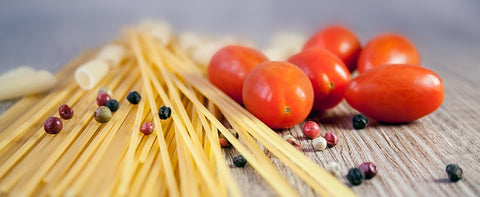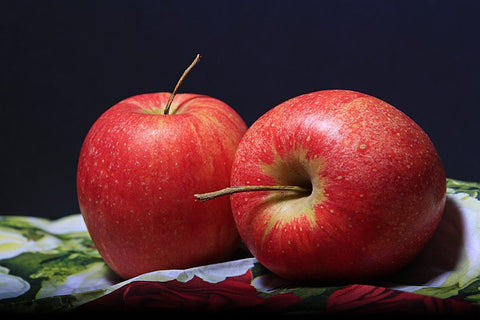10 Foods That Help Control Blood Sugar
One of the most common questions we get is what foods should I eat to help control my blood sugar? Here is a list of 10 foods that you can easily implement into your daily nutrition.
1. Stoneground or Pumpernickel Bread
Many kinds of bread are high in carbohydrates and quickly raise blood sugar levels. As a result, many breads should be avoided. However, pumpernickel bread and 100 percent stone-ground whole wheat bread have low GI scores, at 55 or less on the GI scale.
Pumpernickel and stone-ground whole wheat bread have lower GI scores than regular whole wheat bread because the ingredients go through less processing. Processing removes the fibrous outer shells of grains and cereals. Fiber slows digestion and helps to stabilize blood sugar levels.

2. Al Dente Pasta
Because your body digests pasta more slowly than many other starchy foods, pasta offers you sustained energy without causing fluctuations in your blood sugar. Pasta's ranking on the glycemic index may be lower than bread or potatoes, depending on how long you allow your pasta to cook. When using the glycemic index to plan meals, you can include many forms of pasta without increasing the meal's overall effect on your blood sugar.
Overcooking your pasta affects the quality of its starches and can raise its GI value. The more you cook a starchy food like pasta, the more digestible its starches become, which means that your body converts its carbohydrates to glucose more rapidly. To avoid raising pasta's GI value, boil it only until it's al dente, or slightly firm and chewy, suggests the Glycemic Index Foundation.
3. Steel Cut Oats
Steel Cut and Instant oatmeal are on opposite ends of the oatmeal processing spectrum. On the one hand, Steel Cut oats are the closest thing you can find to oats in their original form. The original oat kernel is cut once or twice with a steel blade to create them ( also known as Irish Oats). They take 25-30 minutes to cook, which may deter some people from purchasing them.
On the other hand, instant oatmeal is essentially the most heavily processed version of oatmeal, requiring as little as 60 seconds to cook. They cook so quickly as a result of an extensive process of cutting, pre-cooking, steaming and flattening.
There are a variety of other types of oatmeal that are available as well and these varieties essentially fall somewhere in between steel cut and instant oatmeal in terms of the level of processing and cooking time.
Despite going through a much more significant processing procedure, instant oats retain most of their original nutritional value. The calorie, fiber and vitamin/mineral values remain very similar between steel cut and instant oatmeal.
The one critical difference between Steel Cut and Instant Oatmeal is how rapidly they are broken down and absorbed into your bloodstream ( and how much/how quickly they raise your blood sugar as a result). Steel Cut oatmeal has a low glycemic index score because it is digested and absorbed slowly and does not raise your blood sugar quickly nor very high. Conversely, instant oatmeal has a high glycemic index score ( similar to white bread ) because it is absorbed quickly and raises your blood sugar rapidly and to higher levels.

4. Apples
Not all fruits are created equal.
Most fruits have a low to moderate glycemic index, the best tool to determine whether a food contains slow or quick-release carbohydrates. If you want to eat only the most slowly released carbohydrates to minimize variations in your blood sugar levels, avoid tropical fruits, such as papaya, mango, and pineapple. Instead, go for berries, melons, cherries, apples, plums, and pears.
Consume whole or cut-up fruit that's minimally processed. Fruit juices, dried fruits, and canned fruits are all quick-release carbs. Adding an apple to your lunch, or apple chunks to a salad for sweetness and crunchy texture will go a long way. Keeping apples in the fridge as a snack can help you deal with evening and late-night cravings for food. You CAN have sweetness in your diet, you just need to be very careful in how it gets delivered into your body.
5. Legumes
Legumes, such as beans, peas, chickpeas, and lentils, have very low GI scores. They are also a good source of nutrients that can help maintain healthy blood sugar levels. These nutrients include:
- fiber
- complex carbohydrates
- protein
Studies have shown that incorporating legumes into the diet improved glycemic control and lowered the risk of coronary heart disease in people with type 2 diabetes. Avoid legume products that contain added sugars and simple starches, such as those in syrups, sauces, or marinades. These additions can significantly increase a product's GI score. So canned baked beans, for example, are not generally a good idea.

6. Cold water fish
Red or white meat or fish have no carbohydrates, so none of these protein sources will raise your blood glucose level. Unless you are a vegetarian, these foods are probably important in your diet. Cold water fish have the most heart-friendly fat called omega-3. Wild Pacific salmon is the best of the best. You should avoid farmed salmon, which aren’t as nutritious because they don’t have as much omega-3. If you have fish allergies or don't like the taste, you can supplement the need for high-quality Omega-3 with high-quality non-fish Omega 3 supplements like Frontline Neuropathy Clinical Omega-3.
7. Gruyere Cheese
Even if you can’t eat most dairy products because of lactose intolerance, you can eat one type of cheese, Gruyere. Lactose is the dairy sugar, and sugar is a carbohydrate. Consequently, a food that has no carbs can’t have any lactose. Fortunately, one great tasting cheese called Gruyere has virtually no carbs (less than 1 gram per 100 gram serving).
8. Nuts and Nut Butter
The most portable foods that won’t spike your blood glucose are some nuts, particularly pecans and macadamias. Pecans have only 1g net carbs per ounce; macadamias have only 2g. The problem with nuts comes when you eat salted ones and eat too many. Fortunately, many stores also offer unsalted pecans and macadamias.
Nuts and nut butter contain very few carbohydrates, and because of their high fiber, protein, and healthy fat content, these carbohydrates are digested at a very slow pace. Adding a few walnuts to a salad, snacking on a handful of macadamia nuts or spreading almond butter on slices of fruits are good options to make you feel fuller and energized until your next meal. Avoid sugar-coated and chocolate-covered nuts and stick to natural nut butter that does not contain any added sweeteners.

9. Avocado
It's easy to assume blood sugar control is all about carbs, but the type of fat you consume matters, too. Monounsaturated fat from foods such as avocados, olives, and walnuts, has been linked to improved insulin sensitivity and lower fasting blood sugar. Try one-quarter of an avocado, mashed, in place of mayonnaise on a roast chicken or turkey sandwich.
10. Water
Some will argue that water isn't a food, but it is contained in most foods and as part of all diets. You CANNOT argue the value of being properly hydrated when it comes to diabetes and prediabetes. In addition to eating more of these foods that lower blood sugar, don't forget to pay attention to what you drink. Sipping more water may be a natural way to balance blood sugar. Some research even suggests that drinking a daily liter of water can reduce the risk of developing high blood sugar by 21 percent. There are a few simple tricks that can help make water taste better such as adding a few orange slices and sprigs of fresh mint for a low-calorie naturally sweetened flavor kick.
